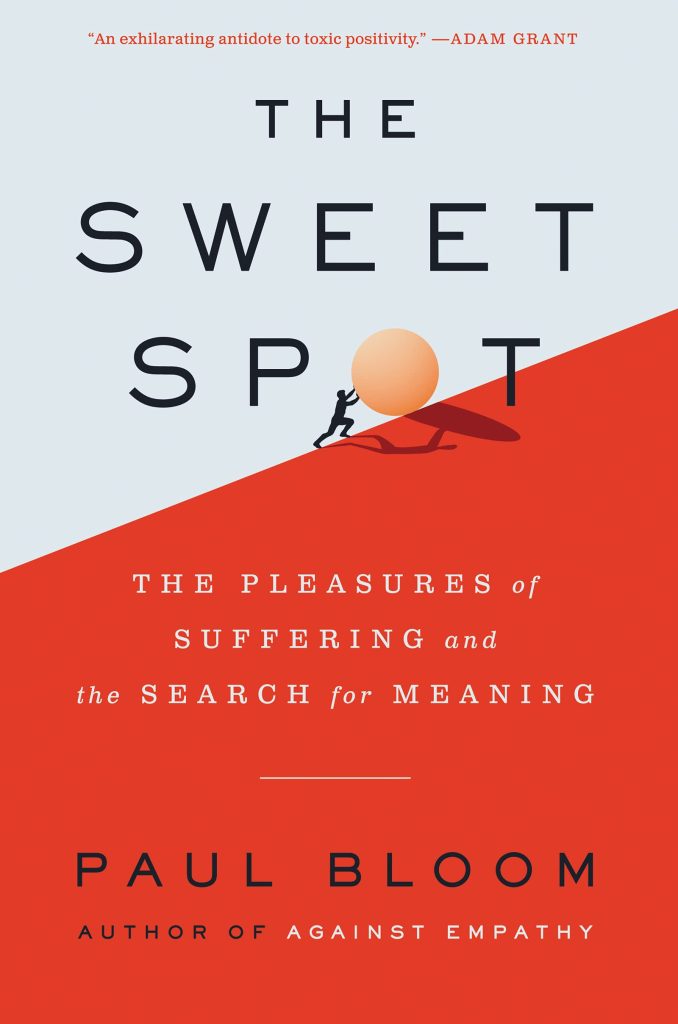The Sweet Spot: The Pleasures of Suffering and the Search for Meaning by Paul Bloom

It’s been ages since I posted about a book I read. Here’s one I read recently that had some ideas related to IRL experience design, though designing experiences was not at all the focus of the book.
Why do people eat really spicy foods? Watch scary movies? Run marathons? Subject themselves other types of physical and emotional pain? That’s the focus of the book. Paul Bloom is a Professor of Psychology at the University of Toronto. Though he’s in the psychology department, I thought the book read more like a philosophy book.
This post is not meant to be a summary of the book. These are just the things I read that were most meaningful to me and/or in the work of IRL experience design.
Terms and Vocabulary
Here’s some terms and random vocabulary mentioned in the book that I were new to me or that I
Benign Masochism
This term (coined by Paul Rozin) refers to the sorts of things (eating spicy foods, sniffy spoiled foods on purpose, pressing on a sprained ankle, etc) that the book talks about. There is of course sexual masochism, but most of the book refers to this voluntary pain and suffering that has no lasting effect and doesn’t have anything to do with sex.
Collective Effervescence
Collective Effervescence is what Emile Durkheim called the sort of rituals and synchronicity that generate empathy and connection
Lassitude
a state of physical or mental weariness; lack of energy
Betimes
before the usual or expected time; early.
The IKEA Effect
The IKEA effect is the term for the phenomenon where people value things they made much more than the same object made by someone else.
Psychological Immune System
Dan Gilbert’s term for how we recover from negative experiences by giving them meaning.
Choice Quotes and Ideas
“Anticipation is an important source of imaginative pleasure”
I think this concept is often overlooked when designing experiences. Helping people anticipate the experience typically has a very low cost and can pay big dividends. Some examples:
- Email teasers in the days leading up to the scheduled visit. These can keep the visit front-of-mind.
- Revealing things in parts or stages, enough to create curiosity. A small house with many doors is more interesting than a gigantic house with one door.
- When they arrive adding to the mystery, sense of discovery, curiosity, excitement with some additional alluding content. Think circus barker, elegant lobby, or other not-core-to-the-content but experience multipliers
Richard Gerrig points out that suspense can be created even if one knows the outcome. (For example, telling the story of how WWII was won). “It’s the surmounting of obstacles that can pull us in; they’re what give the opportunity of pleasure.”
That you can create suspense when the audience knows the ending is a fascinating thing. Nothing shows the power of play more than for visitors to get them to be feel things based on imaginary outcomes that they know aren’t going to happen.
Aversive fictions “serve as a form of imaginative play, allowing us to explore, in a safe way, dangerous and difficult situations”
This echoes other books I’ve read on play. The idea that people can learn to do things in the real world (that they’d rather not do) by doing them in a fake one is an extremely powerful tool. Getting people to test out experiences in a mode of play can help them entertain ideas they would never entertain in the real world.
“Rituals work best, it seems, when their functions are obscured. It’s hard to imagine the Mauritius ritual of the Passover Seder persisting in a culture where everyone was explicit that this was a mechanism to increase group solidarity and there was nothing else to it.”
I’ve bolded this quote because I think it speaks to what I’ve experienced in building the Eureka Room. I invite visitors to visit and have fun in a charming and absurd environment full of weird magical nonsense.
But really what’s behind it – the reason it exists and IMO the real benefit – is connecting people (preferably strangers) through play in order to increase a sense of safety about other people (preferably strangers).
But suppose I explained it in those terms? Ick. Geezuz. Who would want to go to that thing? Borrrring. Probably creepy. No way.
There’s a reason menus are enticing descriptions of food flavors instead of lists of the vitamins and minerals that your intestines will ingest. On some level you are aware of why you eat food but that’s (usually) not what makes you want to eat it. Be selective in which benefits you promote.
Natural disaster reveals “an ordinarily unmet yearning for community, purposefulness, and meaningful work” Rebecca Solnit
This is another fascinating phenomena I’ve wondered about. There’s something very unique and connecting about sharing a disaster with strangers. Or witnessing a mild fender bender with other bystanders. You all just shared a moment and everyone knows it. With natural disaster it’s a whole other level or connection and shared direction. What they say about the rewards of doing something “bigger than yourself” are real.